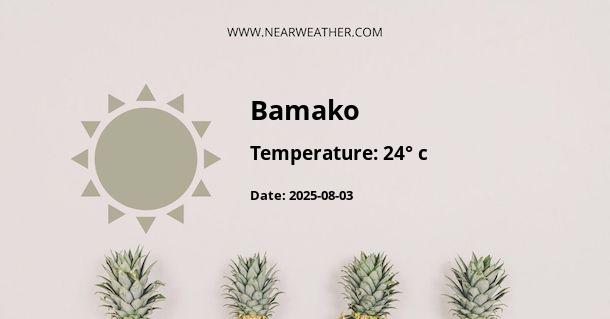Bamako, Mali: Climate and Weather Year Round
Bamako, the capital city of Mali, is located in West Africa and has a semi-arid climate characterized by hot, dry winters and hot, wet summers. In this article, we will explore the weather patterns and climate of Bamako throughout the year.
Temperature
Bamako experiences high temperatures throughout the year, with little variation between seasons. The hottest months are from March to May, with average highs reaching around 38°C (100°F) and sometimes even higher. The coolest months are December and January, when average highs drop to around 30°C (86°F). Nighttime temperatures are generally cooler, ranging from around 15°C (59°F) in winter to 25°C (77°F) in summer.
It is important to note that during the dry Harmattan season, which typically occurs from November to February, temperatures can drop significantly, especially at night. The Harmattan winds blow in from the Sahara Desert, bringing dry and dusty conditions and sometimes causing a temporary drop in temperatures.
Precipitation
Bamako experiences a distinct wet season and dry season. The wet season lasts from June to October, with July and August being the rainiest months. During this time, the city receives an average of around 500mm (20 inches) of rainfall per year. The rain showers often come in the form of heavy downpours, which can lead to localized flooding in some areas.
The dry season, which spans from November to May, is characterized by very little rainfall. From November to February, the Harmattan winds dominate, bringing dry and dusty conditions. It is not uncommon for the city to experience several months without any significant rainfall during this period.
Sunshine and Humidity
Bamako enjoys abundant sunshine throughout the year, with an average of around 9 hours of sunshine per day. The sunniest months are typically from November to April, while the wet season sees a decrease in sunshine hours due to cloud cover.
Humidity levels in Bamako can vary depending on the season. During the wet season, humidity levels are generally higher, ranging from around 40% to 80%. In the dry season, humidity levels drop significantly, often falling below 20%. The combination of high temperatures and low humidity during the dry season can lead to dry and dusty conditions.
Wind Patterns
Bamako experiences relatively calm winds throughout the year, with light to moderate breezes being the norm. The Harmattan winds, mentioned earlier, are prevalent during the dry season and can bring gustier conditions. These dry and dusty winds can sometimes cause visibility issues and affect air quality in the city.
Climate Summary
The climate in Bamako can be summarized as a hot semi-arid climate with distinct wet and dry seasons. The city experiences high temperatures year-round, with the hottest months being from March to May. The wet season lasts from June to October, with July and August being the rainiest months. The dry season spans from November to May, with the Harmattan winds dominating from November to February.
Best Time to Visit
The best time to visit Bamako is during the cooler months of December and January, when temperatures are slightly more comfortable. The dry season from November to February also offers clearer skies and less chance of rainfall. However, it is important to note that the Harmattan winds during this period can cause dusty conditions, so it is advisable to take necessary precautions.
Overall, Bamako's climate offers a unique experience for visitors, with its hot and dry conditions and distinct wet and dry seasons. Whether you're exploring the city's vibrant markets or enjoying the rich cultural heritage, understanding the weather patterns can enhance your visit to this fascinating West African destination.
A - Bamako's Latitude is 12.650000 & Longitude is -8.000000.
A - Weather in Bamako is 25° today.
A - Climate Conditions in Bamako shows overcast clouds today.
A - Humidity in Bamako is 41% today.
A - Wind speed in Bamako is 3.71 km/h, flowing at 220° wind direction. today.
